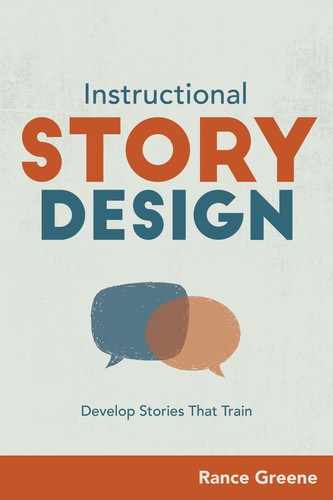CHAPTER SIX
Create Action and Conflict
The Boys and Girls Club
Dayna arrives at the Boys and Girls Club on Saturday. There’s a classroom where James and several high schoolers are gathered in a circle in the middle of a raised platform. Dayna enters quietly and sits in the back row. James hears her, turns around, and introduces Dayna to the group.
“Hey, this is my friend, Dayna, everybody!” Dayna gives the group a small wave. “She’s an instructional designer. I asked her to come watch our scenes today. You need an audience and”—he smiles at Dayna—“she could use some help with story writing.” The kids greet her and smile.
So that’s why he invited me, thinks Dayna. Well, these kids probably know a lot more about how to tell a good story than I do. She settles back in her seat. The high schoolers perform scenes in pairs. Dayna is sure that most of these kids have never performed in their lives. She’s surprised when the first pair, Jamal and Katrina, begin to act out a scene from Romeo and Juliet. Wow, she thinks, James is really stretching these kids … Shakespeare!
They are performing the famous scene where Romeo comes to Juliet’s house by night. “O Romeo, Romeo! wherefore art thou Romeo?” Juliet calls out.
When Katrina gets to the line, “What’s in a name? That which we call a rose, by any other name would smell as sweet,” James stops the scene and asks, “OK, Katrina, that’s good. But what is the action here?”
Katrina looks down at her script, “Um, Juliet wants to be with Romeo.” She looks back up at James. “Right?”
James stands up and walks over to Katrina, “Yes, of course. That’s good. You’re right. She does want to be with Romeo. But what’s the action? Look at the whole line. What is Juliet doing here?” He gives Katrina time to think it over.
“I guess she’s saying that she doesn’t care that Romeo is a Montague and she’s a Capulet?” James smiles and nods, encouraging Katrina to keep going. “And … she just wants to be with him?”
“Good!” James affirms her. “So what do you think the action is behind what she’s saying?”
“Oh!” Jamal starts to say something. “Sorry, I just had an idea.” Katrina doesn’t mind being off the hot seat.
“Go ahead, Jamal,” says James.
Jamal continues, thinking out loud, “Isn’t she kind of denying her family? Well, really, Romeo’s doing that too, right? Aren’t they both, like, deciding to leave their families so they can be with one another, even though their families hate each other?”
“Yes!” James is excited. “What’s the action in what you just said, Jamal?”
“Uh … ” Jamal isn’t certain.
Katrina helps him, “Leaving her family?”
“Good,” says James. “But Jamal used a more powerful word to say that.”
“Denying her family!” Jamal says, smiling.
“Yeah, denying, that was it!” Katrina laughs.
“OK,” says James, walking back to his seat, “Deliver that line again, but this time say it like you are denying your family. Show me the action!”
“Whoa,” Katrina says under her breath. She thinks for a minute and begins at the top of the line. She sounds completely different.
“’Tis but thy name that is my enemy;
Thou art thyself, though not a Montague.
What’s Montague? It is nor hand, nor foot,
Nor arm, nor face, nor any other part
Belonging to a man. O, be some other name!”
Dayna leans forward in her seat. Katrina’s voice rises in pitch and intensity.
“What’s in a name? That which we call a rose
By any other name would smell as sweet.”
Katrina stops, a little shaken by the emotional power in her voice. Everyone is stunned. Then she shakes her head and says, in a total break of character, “I’m not leaving my mama and daddy for some teenage chump!” Everybody busts out laughing.
“That was amazing, Katrina!” Jamal says between laughing. “You’re an actor!”
Katrina flips her hair. “You can call me Diva, Romeo!” Everybody laughs again.
James brings the group back together to focus on their work. Scene after scene, James drives home the same question, “What’s the action?” The class ends and the kids give James high fives and thank Dayna for being their audience before leaving.
Dayna walks up to James. “That was impressive. How do you do that?”
James smiles as he packs his backpack, “Thanks, how do I do what?”
“Those kids came to life for you,” she says.
“I love ‘em,” says James, “and they are amazing kids. They work hard.”
“I could never engage my students like that when I was teaching middle school. I can’t believe you have them doing Shakespeare!”
“Speaking of Shakespeare, how’s your story coming?” he asks.
“Well, I’m no playwright, but I’ve done a little more homework. I just don’t know where to start with the story.”
“Yeah? What kind of homework?” he asks.
Dayna fishes out two pieces of paper from her tote and hands one of them to James. “Well, I actually made up some characters. Do you think it’s alright to make characters up for training?”
“Whoa!” says James, reading over the character descriptions. “I like Steve a lot more now! Of course it’s OK! Fiction is great! Besides they’re based on your employee profile. And who’s this Jasmine lady?”
“Actually,” says Dayna, “it turns out that our customer service area is not mostly men—it’s more of an even split—and that’s who’s sending the spreadsheets with sensitive information … Jasmine.”
“You lost me with the spreadsheet thing,” says James. “But this is great! You actually know who your audience is!”
“You keep using that word, audience,” Dayna laughs. “You make it sound like a performance.”
“Um, you’re an instructional designer.” James teases. “What are you training people on?”
Dayna looks up, then nods. “Performance. OK, I think I get it.”
“You have a lot of good material here for characters who are ready to perform for your audience. What’s on the other paper?”
Dayna hands him the other piece of paper. “It’s the task list for the course.”
“You just happened to have all of this stuff with you on a Saturday?” James laughs. He looks at the paper. “Hey, it says up here at the top that this is an action list?”
“Oh yeah,” says Dayna, “It made it easier to talk with the subject matter expert when I called it a list of actions.”
James gasps. “You are a genius!”
“Not really,” says Dayna.
“No, seriously!” He holds up the two pieces of paper. “You’ve written your story!”
Dayna is confused. “Yeah, but the coupon thing wasn’t really that good.”
“Not that story!” says James. “Look!” He holds up the character descriptions. “Here are your characters.” He holds up the action list. “And here is your action! Boom!”
Dayna isn’t sure she follows. “OK, but a story about Jasmine encrypting an email doesn’t sound like a page-turner.”
James asks, “What have I been asking the kids about their scenes today?”
Dayna didn’t have to think, “What’s the action?”
“Right! What’s the action? Otherwise we’re just hearing words. Remember Katrina? The first time she just quoted the words.”
“Of course!” interrupts Dayna. “It was night and day. She was … denying her family the second time. That was really powerful.”
“It was powerful because she was acting the second time.” James pauses. “I know that the story you are writing is not classic literature. It’s for training. But I think the principle is the same. You’ve got to have action with a purpose.”
“Agreed,” says Dayna, “So, what is the purpose?”
“Well, think about Romeo and Juliet. What if, after Romeo and Juliet get married, their families decide to work things out. Their parents take turns spending holidays with the grandchildren. And everything’s great!?” Dayna laughs. “See!” he says, “There’s plenty of action, but what do you think is missing in that version?“
“Friction?”
“Good word,” says James. “There’s no friction, or conflict.”
“OK,” says Dayna. “So my story needs action and it needs conflict.”
“Right, but they aren’t separate things. They need to be the same. The action is the conflict. Juliet denying her family is the conflict in that scene.” He goes on, “It’s nice if Steve doesn’t click the phishing link or Jasmine sends an email properly, but that’s not the kind of action you want. There’s no conflict. People are going to forget those stories.”
“So, why tell them if they’re going to be forgotten?” reasons Dayna.
“Right. But if Jasmine is swamped at work and mistakenly sends the email with private stuff … I don’t know, what happens after that?”
“There’s this complicated disclosure tracking they have to do that can take weeks,” explains Dayna.
James interjects, “… which is a stressor, right? So there’s some conflict.”
Dayna sees where James is heading and is about to ask him how he would describe the conflict in Steve’s situation, but James interrupts.
“I’m starved,” he says, lifting his backpack onto his shoulder and heading out the door. “Wanna grab a bite? I’ve got an hour before my rehearsal.”
“You’re coming back here?” asks Dayna.
“No, I’m in a local production of Mary Poppins and we open next weekend.”
“Mary Poppins? What’s your role?” asks Dayna.
But James is out the door, whistling “A Spoon Full of Sugar.” Dayna follows, shaking her head. Hanging out with James is never boring.
What’s Wrong With This Picture?
Remember Dayna’s first attempt at a story in chapter 5? She showed it to James and got some good feedback. Take a moment and read through her short story again and apply what you’ve learned so far about good storytelling for training (Figure 6-1).
Figure 6-1. Dayna’s First Cybersecurity Story

What advice would you give Dayna to make her story better? After you’ve given it some thought, take a look at the following suggestions as a review of the Story Design principles you’ve gained so far (Figure 6-2).
Figure 6-2. Evaluating Dayna’s Story

Let’s make the connection between that action and the story more concrete. This will lay the groundwork for the next chapter, where you will write the story’s plotline and dialogue.
Show the Action
Dayna’s story begins with a telling phrase, “This is a story about … ” Dayna then proceeds to give away the story by telling us what it’s all about instead of letting the learner discover it by observing the action. She tells us about an employee. She tells us about a phishing email. She tells us about what not to do. But what if she showed us the action instead of telling us about it? Dayna can use these three questions to create meaningful action for her story.
• Is the character doing realistic things?
• Is the action conflict?
• Is the character motivated to do these actions?
Use these questions to begin the process of writing the story. When you’ve completed the story, you may also ask these questions as an evaluation.
Is the Character Doing Realistic Things?
In Dayna’s original story, the employee, whom Dayna has named Steve, passively receives an email and internally realizes that it is a scam. Also, that Steve would be lured to click on a link containing store coupons seems unrealistic now given his character description. Or, at least, too general to be believable. What are some things that you could realistically imagine Steve doing in this scene that fit his character? Review his character description and the actions below. Which ones strike you as observable and realistic?
Figure 6-3. Steve’s Character Description and Actions
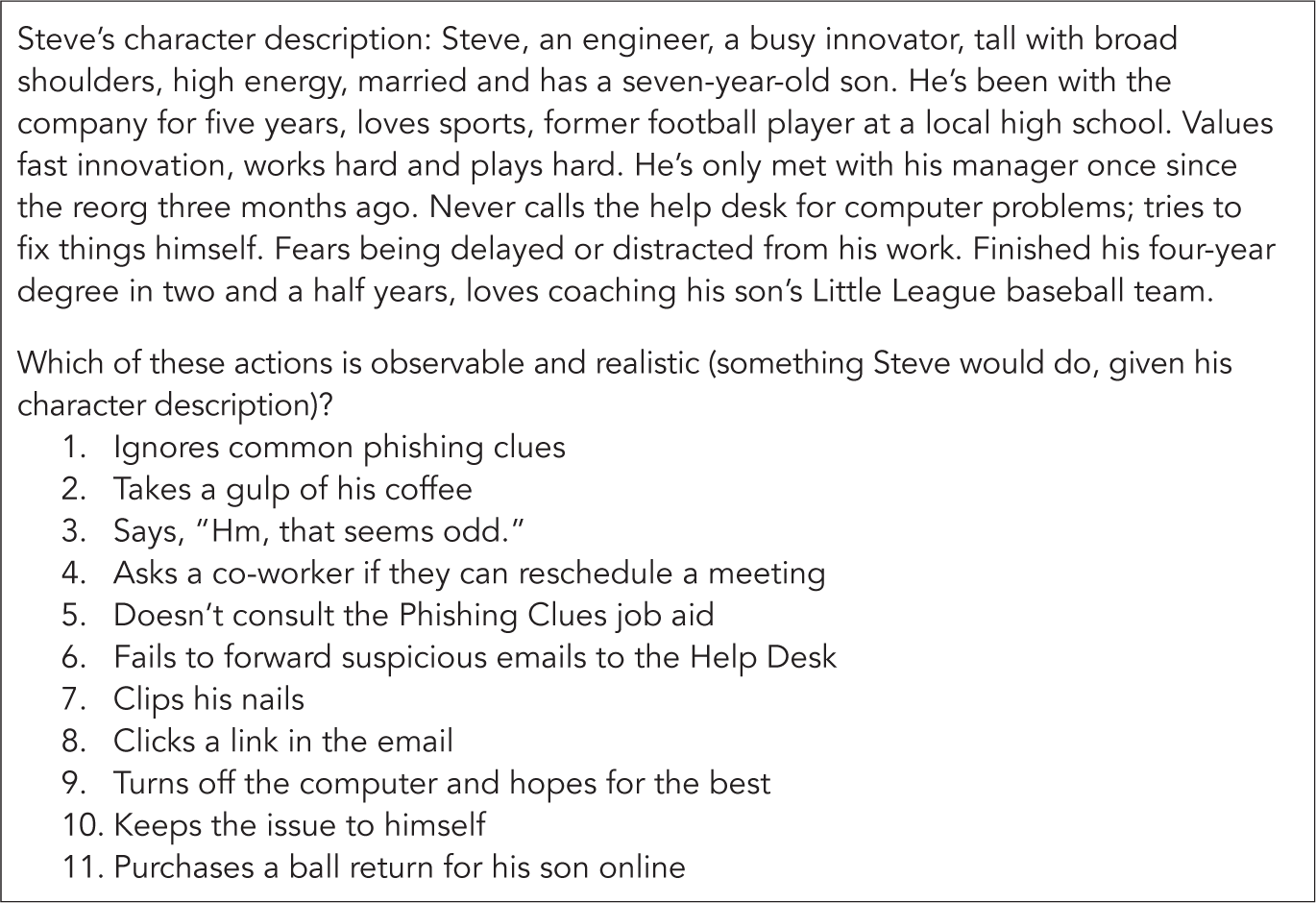
Just as the action list must be observable action, the action in your story must also be observable. The character must be doing things. You can delete numbers 1, 5, 6, 10, and “hopes for the best” from number 9. You’re left with the following observable actions:
• takes a gulp of his coffee
• says, “Hm, that seems odd.”
• asks a co-worker if they can reschedule a meeting
• clips his nails
• clicks a link in the email
• turns off the computer
• purchases a ball return for his son online.
Though clipping his nails is an observable action, it seems out of character for Steve as something we would see him do in a story. That reduces the list to the following:
• takes a gulp of his coffee
• says, “Hm, that seems odd.”
• asks a co-worker if they can reschedule a meeting
• clicks a link in the email
• turns off the computer
• purchases a ball return for his son online.
Any of these actions could be performed in the scene, but not all of them directly contribute to the conflict.
Figure 6-4. Strong Conflict and Desire for Resolution in the Story Design Model

Is the Action Conflict?
The purpose for showing the conflict through action is to produce a desire for resolution within the learner. Dayna needs to put Steve in more direct conflict with the action list. Review Dayna’s action list below and think of some things that Steve could actively do that are in conflict with the three sub-actions.
Main action: Protect the company’s information from scammers.
1. Scan emails for common phishing clues using the Phishing Clues job aid.
2. Forward suspicious emails to the help desk without clicking links or opening attachments.
3. Report suspected breaches in security.
a. Call cybersecurity office.
b. Notify your supervisor.
Is it difficult? Yes, sometimes it is challenging to identify an observable action that is in conflict with the action list. From Dayna’s list of actions that follow, mark the ones that directly conflict with the action list.
• takes a gulp of his coffee
• says, “Hm, that seems odd.”
• asks a co-worker if they can reschedule a meeting
• clicks a link in the email
• turns off the computer
• purchases a ball return for his son.
Below are the three actions that Dayna has identified as something that is in conflict with the action list and some tips on how to do this for yourself in the practice section of this chapter.
• Says, “Hm, that seems odd.” This action is not necessarily in direct conflict with the first sub-action on the action list, “Scan emails for common phishing clues using the Phishing Clues job aid,” but it clues the listener of the story in on the fact that Steve recognizes that there is something wrong with the email and does nothing about it. You may think the verb, says, is not the most powerful verb in the world. But think about it. The character is actually talking. That’s observable and realistic, so don’t rule out speaking as an action. You’ll learn more about speaking and dialogue in the next chapter.
• Clicks a link in the email. This one is an easy contrast to “Forward suspicious emails to the help desk without clicking links or opening attachment.” This action is clearly in direct conflict with the action list. He doesn’t forward the email and he clicks the link. When actions from the action list have an obvious conflict associated with them, make it easy on yourself and seize it an action for your story.
• Turns off the computer. He does this instead of “Report suspected breaches in security.” There could be several conflicts with this action, but we know from the character description that Steve tries to fix his own computer problems instead of calling the help desk. It’s plausible that turning off his computer could be his attempt at a quick fix for stopping a computer virus. Think of how your character might react if the consequences were severe.
Read through the three actions above. Steve says, “Hm, that seems odd.” Then he clicks a link. Then he turns off his computer. With these three actions, which are in contrast to the actions on the action list, we see the beginnings of a plot unfolding.
Is the Character Motivated to Do These Actions?
Our behaviors in everyday life don’t happen in a vacuum and neither should your characters’ actions. Look at your character descriptions—their values, their reactions to current circumstances, their fears, and their personal information—to find valuable material for why they may do the things they do in the story. Dayna has an idea of the actions Steve needs to take in the story, but why would Steve do these things? Dayna can use the three actions as a place to start and cross-check them with the character description to make sure there is a viable reason for Steve to do them. Look at the table below and complete the second column (Figure 6-5).
Figure 6-5. Motivation Chart for Steve

After you’ve thought it through, take a look at Dayna’s reasons (Figure 6-6). Are they similar?
Figure 6-6. Dayna’s Motivation Chart for Steve
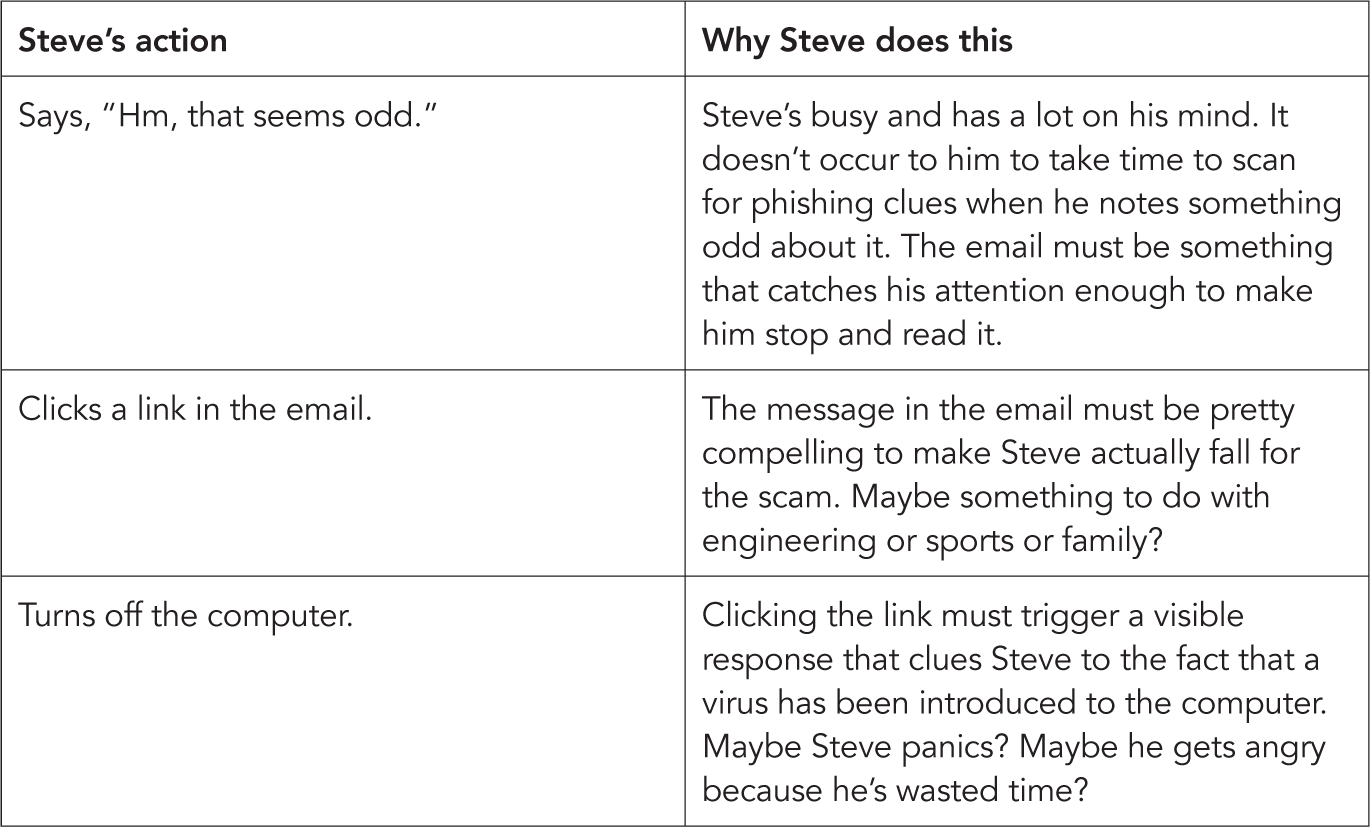
In the next chapter, as you build the story, you will look for opportunities to bring the motivations from the second column into the plot. You want to intensify the conflict to the strongest level possible. Outward and inward pressures on the characters push the action of the story to strong, believable conflict.
Can conflict be intensified too much? It’s rare that I’ve had to pull a workshop participant back from making their conflict too strong. But on occasion, it has happened. Once, someone wrote a story in which the conflict revolved around two front desk staff members talking about the personal information of a client loudly while the patient was in earshot of the conversation. The client was none too happy about it and by the end of the scene, there was a dead body on the floor! Unless you’re doing training for emergency personnel or staging a Shakespearean tragedy, nobody should end up dead. If the conflict deviates from the action list or is so intense that it causes something to happen in the scene that distracts from the training, pull it back a notch and let your characters live.
Jasmine and Andrew Take Action
Dayna repeats the Show the Action process with a story for the privacy training. Review how Dayna uses the action list and character descriptions to show the action (Figure 6-7).
Figure 6-7. Dayna’s Action List and Character Descriptions for Privacy Story

Dayna decides to focus the story on the major problem that exists in the company: 1(c), “Delete rows, instead of hiding them, in attached spreadsheets that contain more than the minimum necessary.” The action of the story will be mostly in conflict with this one action. Dayna’s job is a little more complex. She’s writing action for two characters instead of one. But she can use two characters to her advantage by placing one of the characters in direct conflict with the action and the other as a foil. Dayna walks through the three steps for showing the action for the Jasmine and Andrew story.
• Is the character doing realistic things?
• Is the action conflict?
• Is the character motivated to do these actions?
Is the Character Doing Realistic Things?
Read through the character descriptions and imagine what they might be doing. At this point, don’t worry if it’s directly related to the action list. Picture them sitting at Andrew’s desk with Jasmine listening in on the call he’s taking. Picture them talking with one another. What things are they doing? Also, how might those things contrast one another? Can you see them doing these things?
Figure 6-8. Dayna’s Characters’ Actions
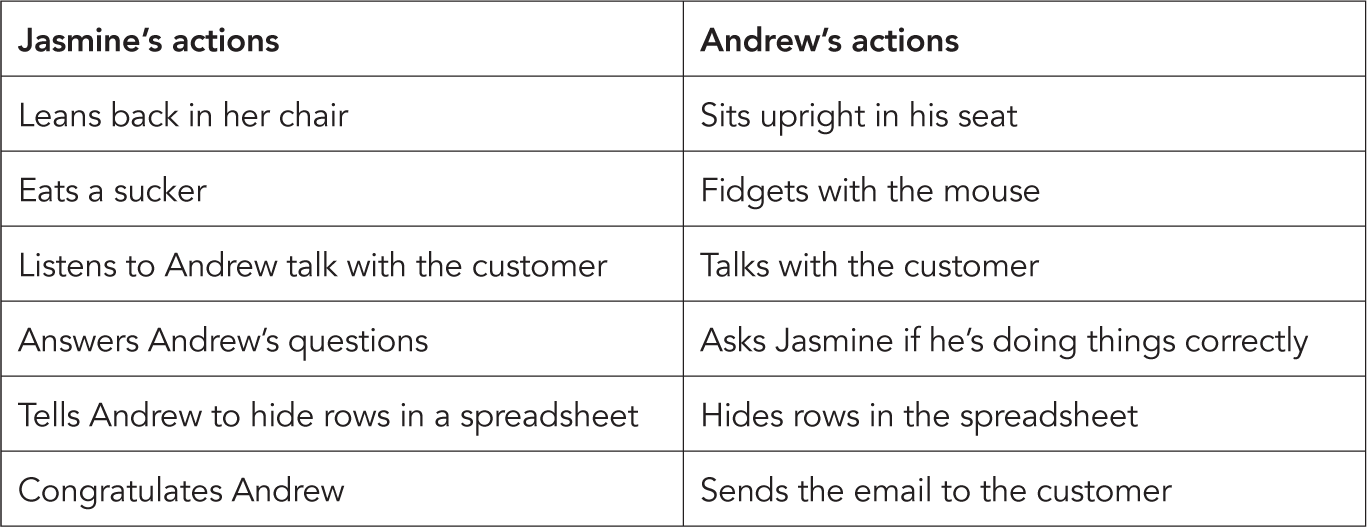
Is the Action Conflict?
Though all these actions may advance the story’s plot in some way, there is only one action that must remain intact: “Tells Andrew to hide rows in a spreadsheet” (Jasmine) and “Hides rows in the spreadsheet” (Andrew). This aligns directly with the action list. The other actions provide insights into their character and make the story more believable. Don’t get married to Jasmine eating a sucker or Andrew sitting upright in his seat, but don’t throw them out completely either. If you were able to see the characters doing these things in your mind, you may be able to design a story that helps learners see them doing these things as well.
Is the Character Motivated to Do These Actions?
Let’s focus on the undisputed action that must remain in the story for each of these characters. Why do Jasmine and Andrew take this action?
Figure 6-9. Dayna’s Character Motivations

Notice that Dayna’s reasons for her characters hiding rows in a spreadsheet are aligned with their character descriptions. Notice also that other than Andrew possibly questioning Jasmine about hiding rows in the spreadsheet, there is little interpersonal conflict, which is appropriate as the action list and the audience profile do not indicate that interpersonal conflicts are a major issue. You will note, however, that in the practice session, you will have ample opportunity to introduce interpersonal conflict in the story you are creating for the Well Adjusted clinic.
Conflict Is Real
You saw in chapter 5 how to use guideposts to make your characters real. Use the principles of Show the Action to make your conflict just as real. Once you kindle that desire, they are ready to learn. In appendix 1, use the Show the Action as your guide.
Figure 6-10. Show the Action Worksheet
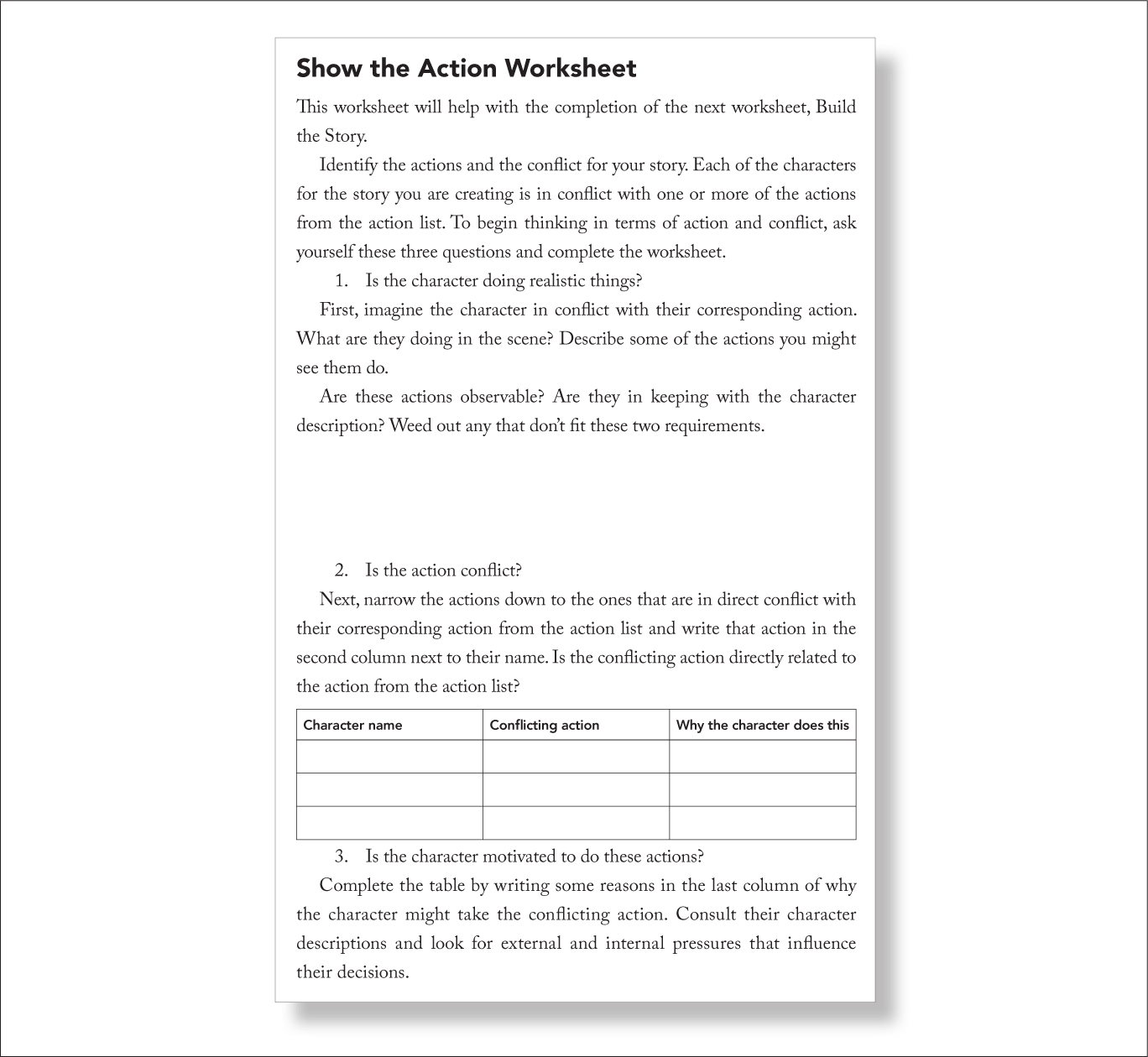
You may download an editable version of the worksheet at needastory.com/book-resources.
PRACTICE STORY DESIGN:
Show the Action
Using the character descriptions you created from chapter 5 and the action list from chapter 4, identify the action and the conflict for your story. Each of the characters for the story you are creating for Well Adjusted is in conflict with one of the actions from the action list.
Is the character doing realistic things?
First, imagine Character 1 in conflict with their corresponding action. What are they doing in the scene? Are they with Character 2? Are they with a patient? Are they with other staff members? Describe some of the actions you might see them do in the space below, then do the same for Character 2.
Are the above actions observable? Are they in keeping with the character description? Weed out any that don’t fit these two requirements.
Is the action conflict?
Next, narrow the actions down to the one that is in direct conflict with their corresponding action from the action list and write that action in the second column next to their name.
| Character name | Conflicting action | Why the character does this |
| |
|
|
| |
|
|
Is the conflicting action directly related to the action from the action list? Is it a positive action that can be observed? If you’re getting stuck, remember, your character can speak. Also, think of how your character might react if the consequences are severe, like in Dayna’s story. Steve shuts off his computer in response to the virus. Think it through. Picture it. Write it down.
Is the character motivated to do these actions?
Complete the preceding table by writing some reasons in the last column of why the character might take the conflicting action. Consult their character descriptions and look for external and internal pressures that influence their decisions. You will use this column to heighten the conflict in the story.
For your first Story Design projects, complete the Show the Action table for each character and each of their conflicting actions. Over time, this discipline will become ingrained and you may choose to skip to the next step of building the story, keeping these principles in mind. When you’ve completed the table, read through each character’s action and reasons for doing so. Does a plot come to mind? Conversations? Consult the completed Instructional Story Design Plan for further understanding after you’ve completed this exercise.
You’re well on your way to realizing a fully designed story.
